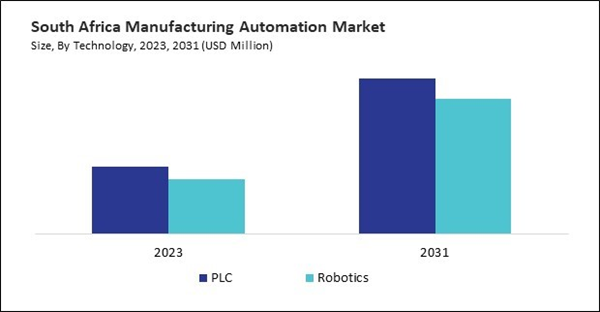The Brazil market dominated the LAMEA Manufacturing Automation Market by Country in 2023, and is expected to continue to be a dominant market till 2031; thereby, achieving a market value of $423.9 million by 2031. The Argentina market is showcasing a CAGR of 12.8% during 2024-2031. Additionally, the UAE market would register a CAGR of 10.5% during 2024-2031.
Automation technologies are being progressively adopted by small and medium-sized enterprises (SMEs), which comprise 90% of all companies worldwide, in addition to large multinational corporations. While SMEs may not have the same level of resources as larger companies, automation allows them to compete on a more level playing field.
Moreover, in many cases, automation allows SMEs to scale up their operations without significant increases in labor or infrastructure. This is particularly important in sectors such as food processing, where automation can help small manufacturers meet growing consumer demand while maintaining competitive pricing.
The manufacturing automation market is undergoing substantial development throughout the LAMEA region, and this growth is being fueled by the growing e-commerce and healthcare sectors. As e-commerce platforms become more prominent globally, logistics providers and manufacturers increasingly turn to automation to handle the rising demand for faster and more efficient order fulfillment. In South Africa, the expansion of e-commerce and healthcare is similarly fueling a need for automation in manufacturing. E-commerce platforms have grown exponentially following the pandemic, leading to increased demand for automated systems in warehouses and fulfillment centers to handle higher volumes of online orders.
Based on Enterprise Size, the market is segmented into Large Enterprises and SMEs. Based on End-Use, the market is segmented into Discrete Manufacturing and Process Manufacturing. Based on Component, the market is segmented into Hardware, Software, and Services (Managed Services and Professional Services). Based on Technology, the market is segmented into PLC and Robotics. Based on Solution, the market is segmented into Monitoring & Diagnostics, Control Systems, and Robotics & Autonomous Systems. Based on Deployment, the market is segmented into On-premises and Cloud-based.
List of Key Companies Profiled
- ABB Group
- FANUC Corporation
- Honeywell International, Inc.
- Mitsubishi Electric Corporation
- Omron Corporation
- Rockwell Automation Inc.
- Schneider Electric SE
- IBM Corporation
- Siemens AG
- Emerson Electric Co.
Market Report Segmentation
By Enterprise Size
- Large Enterprises
- SMEs
By End-Use
- Discrete Manufacturing
- Process Manufacturing
By Component
- Hardware
- Software
- Services
- Managed Services
- Professional Services
By Technology
- PLC
- Robotics
By Solution
- Monitoring & Diagnostics
- Control Systems
- Robotics & Autonomous Systems
By Deployment
- On-premises
- Cloud-based
By Industry Vertical
- Automotive
- Consumer Electronics
- Transportation & Logistics
- Healthcare
- Other Industry Vertical
By Application
- Assembly Line Automation
- Material Handling Automation
- Transportation & Logistics
- Welding & Fabrication Automation
- Packaging Automation
- Other Application
By Country
- Brazil
- Argentina
- UAE
- Saudi Arabia
- South Africa
- Nigeria
- Rest of LAMEA
Table of Contents
Companies Mentioned
- ABB Group
- FANUC Corporation
- Honeywell International, Inc.
- Mitsubishi Electric Corporation
- Omron Corporation
- Rockwell Automation Inc.
- Schneider Electric SE
- IBM Corporation
- Siemens AG
- Emerson Electric Co.
Methodology

LOADING...









